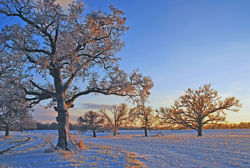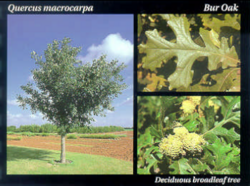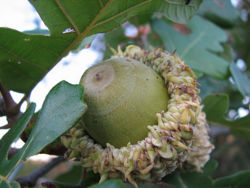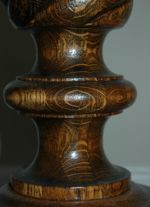Bur oak
| Bur oak |
|---|

|
| Scientific Classification |
|
| Binomial Name |
|
Quercus macrocarpa |
The Bur Oak (Quercus macrocarpa) tree has been known for many things such as its height, trunk size, and years it may live. Along with all these qualities it is also given many names such as "prairie Oak", "blue Oak," scrub Oak", or "mossycup Oak". It is often called the "prairie oak" because back before prairie land turned into farm land, the bur oak tree was known to grow out in the open prairie land and withstand the grass fires. These trees have been known to grow up to 95 feet tall, 319 inches in circumference, and a branch span of 102 feet. It has a nut that grows as its fruit which can be as big as 1 inch. Along with this large tree and acorns come large leaves. These leaves can be as big as 12 inches long. With the tree's amazing size and significance it can live up to 400 years.
Anatomy and Ecology
These trees are native to North America in it's eastern and Midwestern parts and also in parts of southern Canada. It is a very large deciduous tree that can grow up to 37 meters in height, and has the largest Oak tree trunk with a diameter of 3 meters. It has a rate of growth of 60-100 centimeters a year. It's bark is a medium gray color and contains a rugged texture. Some trees however have a patch of shallow smooth bark surrounded by its usual rugged texture.[1] These smooth patches are caused by fungi eating away at the rough outer layer. This is a disease known as "smooth patch" which is not harmful to the tree. Many consider it as dandruff for the tree. The twigs on the Bur Oak are stout and have a corky ridges to them. The leaves of a Bur Oak have a span of 7-15 centimeters long and 5-13 centimeters wide. The flowers that grow on these leaves are a green-yellow color called Catkins, that grow in the spring. The acorns that grow on this tree have a cup like figure wrapped around it, and a growth of 5 centimeters long and 4 centimeters wide. These trees have been known to live up to 400 years old! These trees typically grow out in the open near waterways, and away from all forest areas. These trees are fire resistant and have possess a special taproot that allows them to be resistant against drought. After a tree's first two years of growing it's taproot has already grown as big as 2 meters in length. It's acorn are known as the biggest acorns of the American Oak tree family.[2]
Reproduction
This tree's reproduction occurs mainly by animals taking it's acorns and leaving them to germinate in many places. Things such as birds take them for food and forget about them, and then they are left to reproduce it's self.
Significance
The bark of a Bur Oak tree is very strong and durable making it very useful for things such as ships and furniture. Since it's wood is not porous it is often made into barrels, along with being used as burning wood since it burns longer and hotter then an equal volume of any other type of wood. It's acorns are a great source of food.[3] Many things such as wildlife and Indians eat these acorns as their balanced diet. They are both rich in carbohydrates and fats, and are a favorite source of food of the turkey, squirrel, and deer. Blue jays often carry these acorns miles away so they can be eaten but many are forgotten and left there which help the Bur Oaks germinate.[4]
Gallery
See Also
 Browse |





